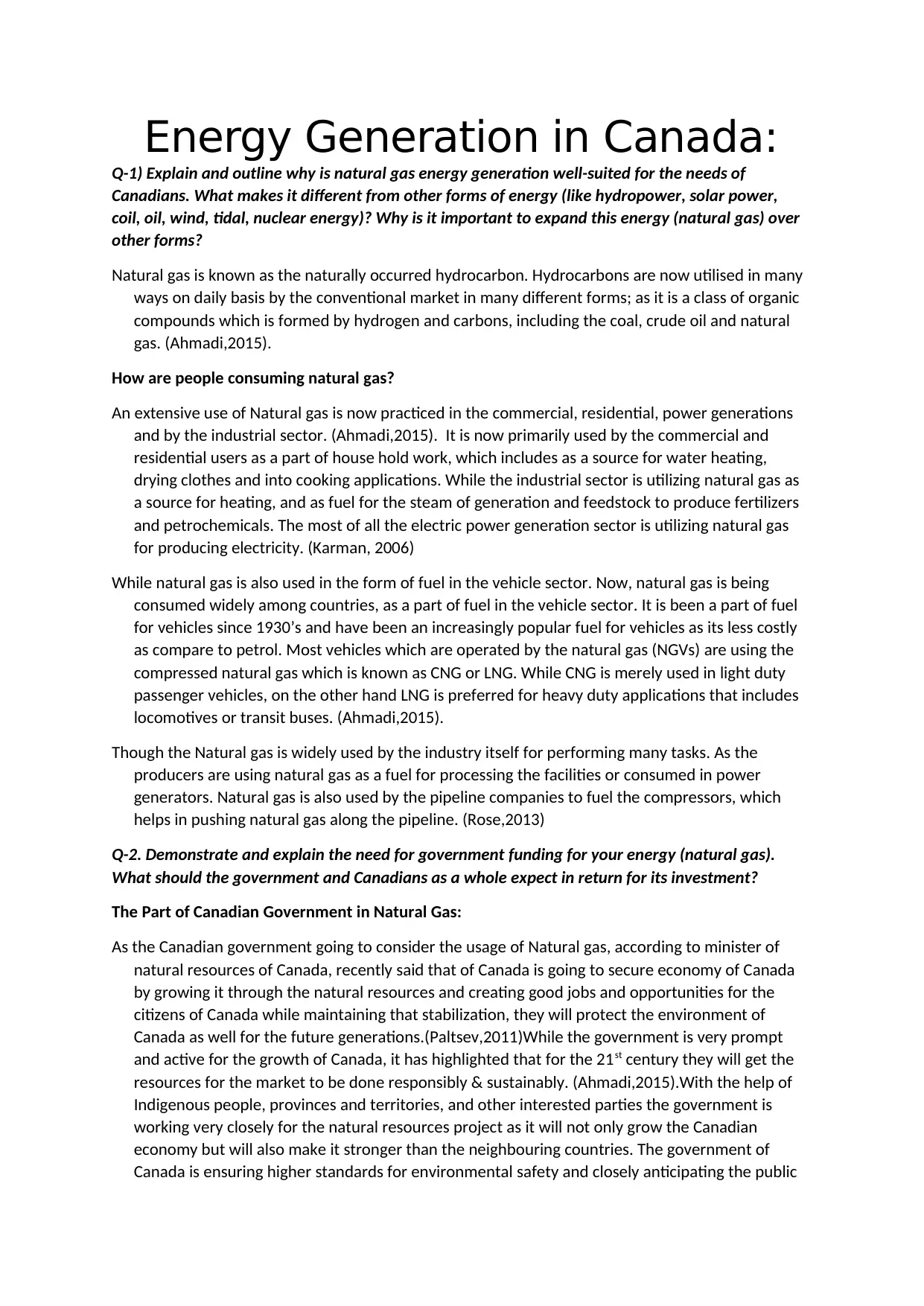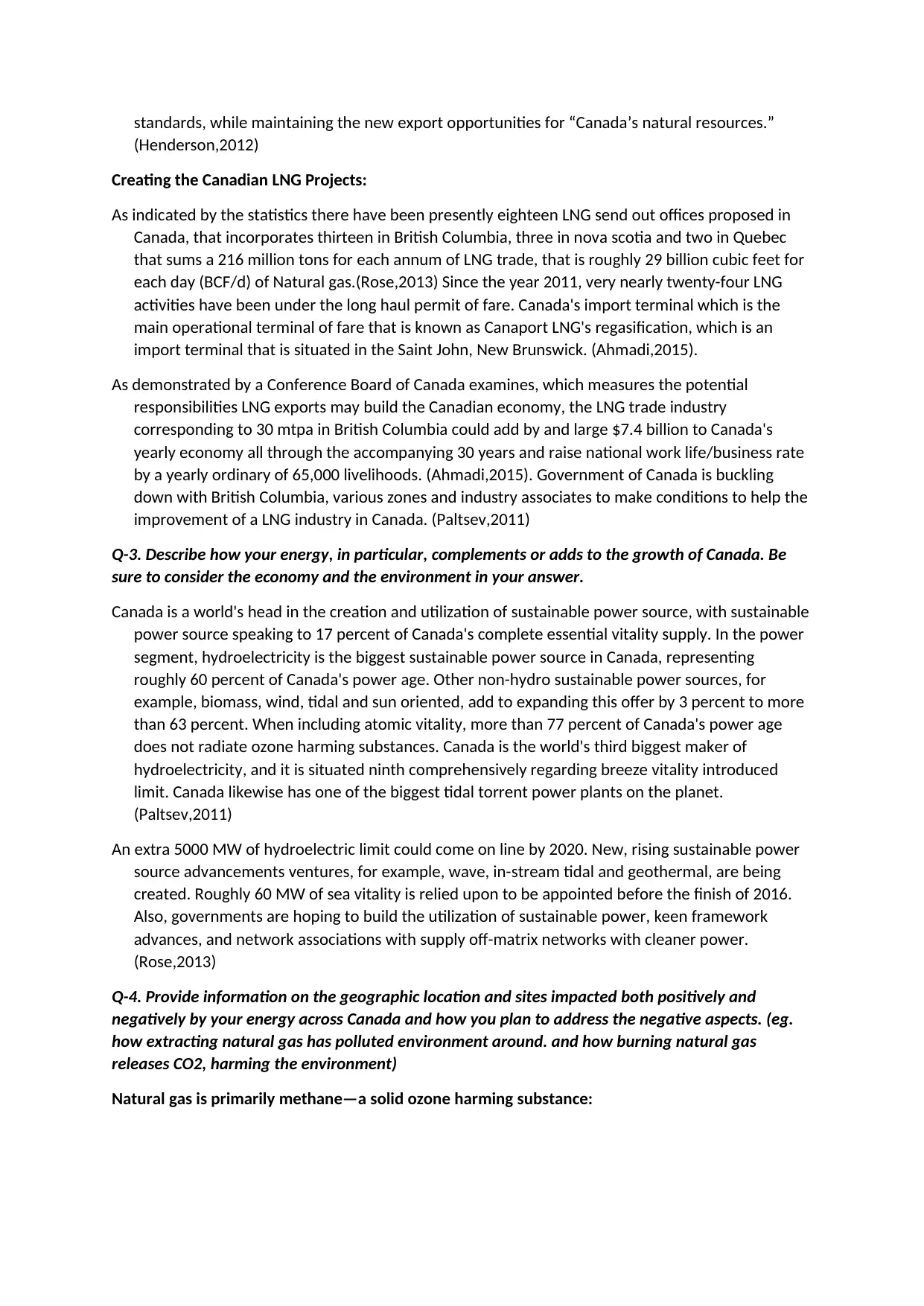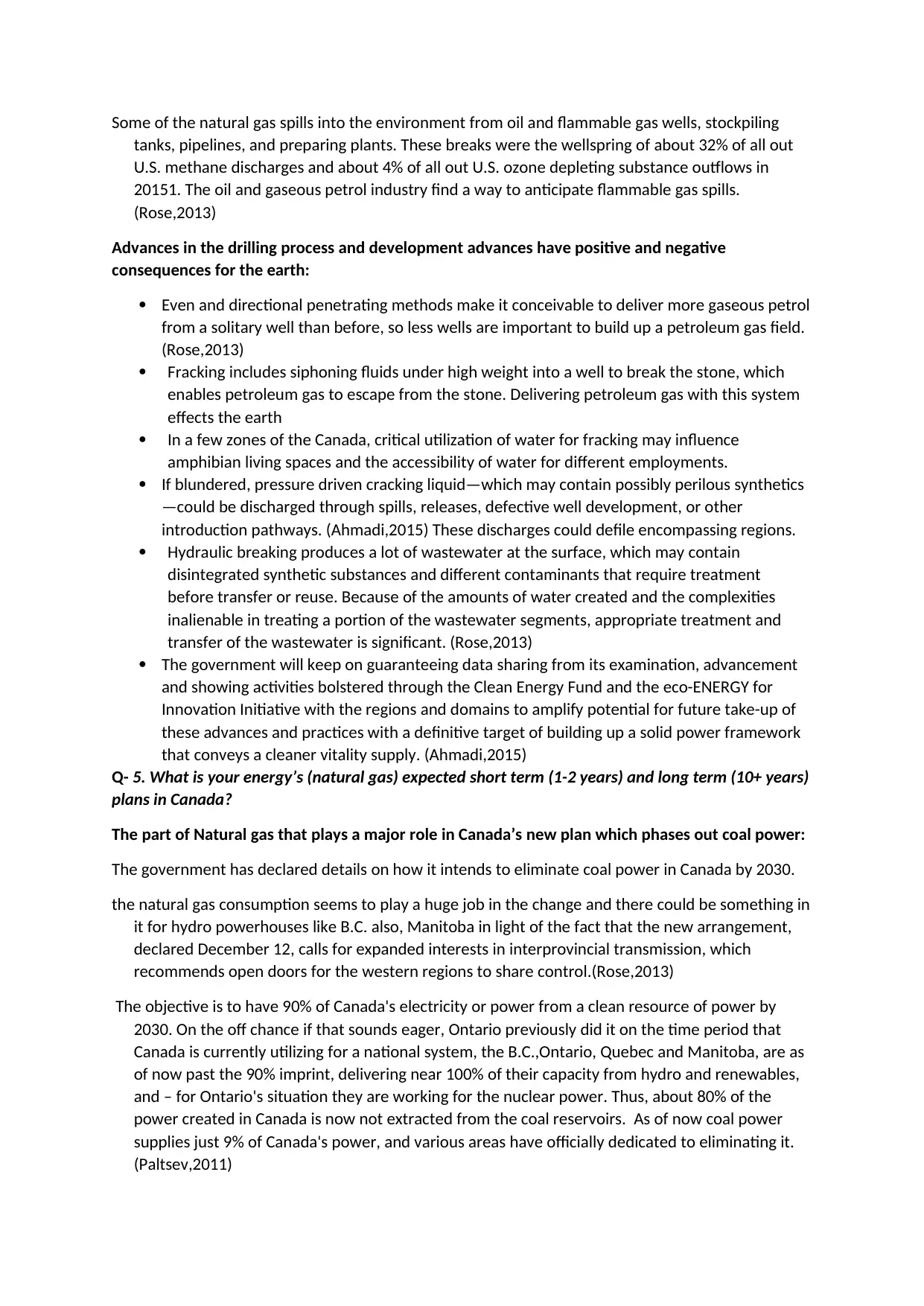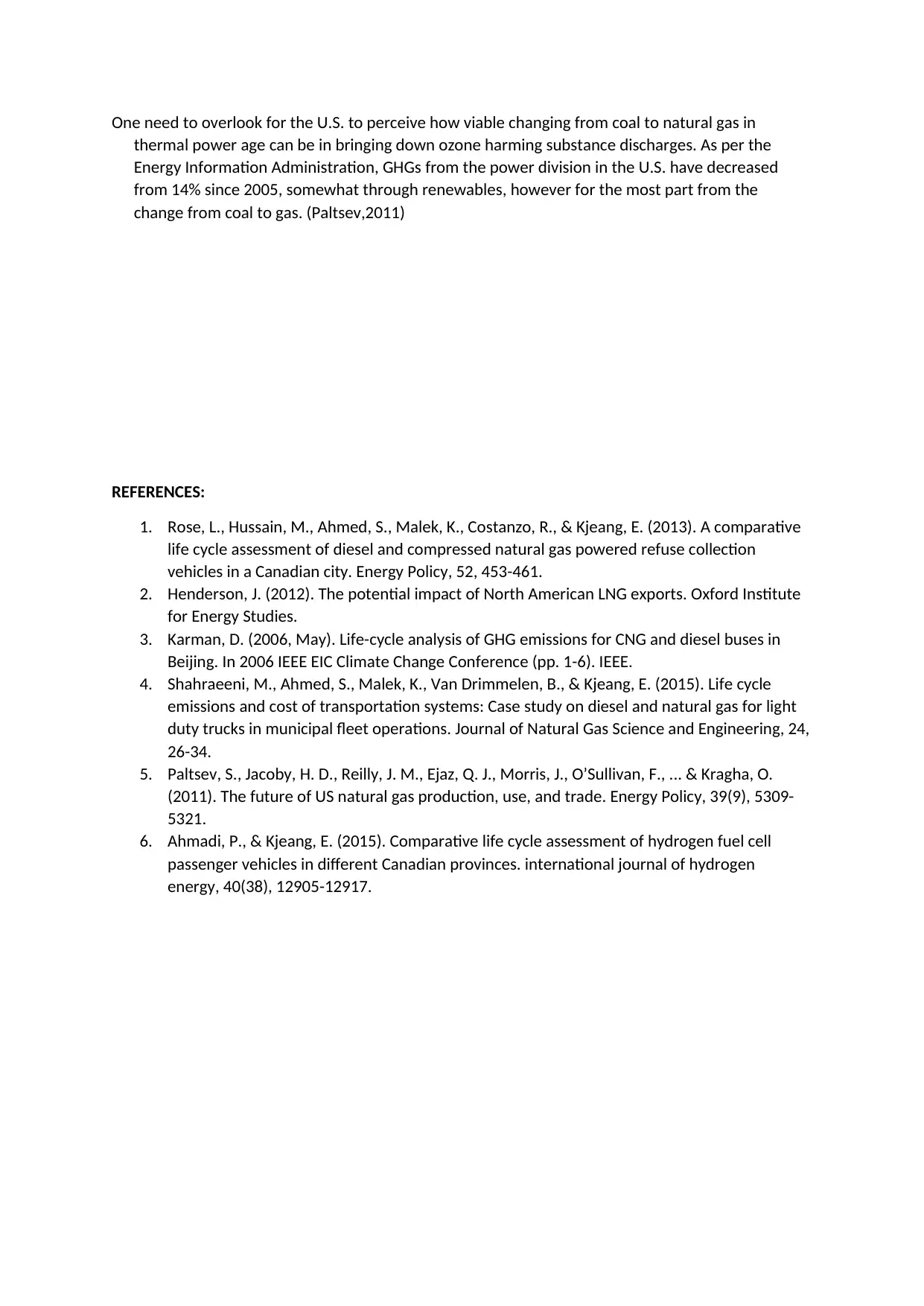Natural Gas Energy Generation: Needs, Funding, and Growth in Canada
VerifiedAdded on 2023/03/29
|4
|1885
|194
Report
AI Summary
This report examines the role of natural gas in Canada's energy sector, highlighting its suitability for Canadian needs compared to other energy sources. It discusses the necessity of government funding for natural gas projects and the expected returns on investment, including economic growth and environmental stewardship. The analysis covers how natural gas complements Canada's growth, considering both economic and environmental factors. It addresses the geographic impacts of natural gas extraction and usage, outlining plans to mitigate negative environmental effects. Finally, the report explores the short-term and long-term plans for natural gas in Canada, particularly in phasing out coal power and transitioning to cleaner energy sources. The document references various studies and reports to support its arguments and provide a comprehensive overview of natural gas energy in Canada.

Energy Generation in Canada:
Q-1) Explain and outline why is natural gas energy generation well-suited for the needs of
Canadians. What makes it different from other forms of energy (like hydropower, solar power,
coil, oil, wind, tidal, nuclear energy)? Why is it important to expand this energy (natural gas) over
other forms?
Natural gas is known as the naturally occurred hydrocarbon. Hydrocarbons are now utilised in many
ways on daily basis by the conventional market in many different forms; as it is a class of organic
compounds which is formed by hydrogen and carbons, including the coal, crude oil and natural
gas. (Ahmadi,2015).
How are people consuming natural gas?
An extensive use of Natural gas is now practiced in the commercial, residential, power generations
and by the industrial sector. (Ahmadi,2015). It is now primarily used by the commercial and
residential users as a part of house hold work, which includes as a source for water heating,
drying clothes and into cooking applications. While the industrial sector is utilizing natural gas as
a source for heating, and as fuel for the steam of generation and feedstock to produce fertilizers
and petrochemicals. The most of all the electric power generation sector is utilizing natural gas
for producing electricity. (Karman, 2006)
While natural gas is also used in the form of fuel in the vehicle sector. Now, natural gas is being
consumed widely among countries, as a part of fuel in the vehicle sector. It is been a part of fuel
for vehicles since 1930’s and have been an increasingly popular fuel for vehicles as its less costly
as compare to petrol. Most vehicles which are operated by the natural gas (NGVs) are using the
compressed natural gas which is known as CNG or LNG. While CNG is merely used in light duty
passenger vehicles, on the other hand LNG is preferred for heavy duty applications that includes
locomotives or transit buses. (Ahmadi,2015).
Though the Natural gas is widely used by the industry itself for performing many tasks. As the
producers are using natural gas as a fuel for processing the facilities or consumed in power
generators. Natural gas is also used by the pipeline companies to fuel the compressors, which
helps in pushing natural gas along the pipeline. (Rose,2013)
Q-2. Demonstrate and explain the need for government funding for your energy (natural gas).
What should the government and Canadians as a whole expect in return for its investment?
The Part of Canadian Government in Natural Gas:
As the Canadian government going to consider the usage of Natural gas, according to minister of
natural resources of Canada, recently said that of Canada is going to secure economy of Canada
by growing it through the natural resources and creating good jobs and opportunities for the
citizens of Canada while maintaining that stabilization, they will protect the environment of
Canada as well for the future generations.(Paltsev,2011)While the government is very prompt
and active for the growth of Canada, it has highlighted that for the 21st century they will get the
resources for the market to be done responsibly & sustainably. (Ahmadi,2015).With the help of
Indigenous people, provinces and territories, and other interested parties the government is
working very closely for the natural resources project as it will not only grow the Canadian
economy but will also make it stronger than the neighbouring countries. The government of
Canada is ensuring higher standards for environmental safety and closely anticipating the public
Q-1) Explain and outline why is natural gas energy generation well-suited for the needs of
Canadians. What makes it different from other forms of energy (like hydropower, solar power,
coil, oil, wind, tidal, nuclear energy)? Why is it important to expand this energy (natural gas) over
other forms?
Natural gas is known as the naturally occurred hydrocarbon. Hydrocarbons are now utilised in many
ways on daily basis by the conventional market in many different forms; as it is a class of organic
compounds which is formed by hydrogen and carbons, including the coal, crude oil and natural
gas. (Ahmadi,2015).
How are people consuming natural gas?
An extensive use of Natural gas is now practiced in the commercial, residential, power generations
and by the industrial sector. (Ahmadi,2015). It is now primarily used by the commercial and
residential users as a part of house hold work, which includes as a source for water heating,
drying clothes and into cooking applications. While the industrial sector is utilizing natural gas as
a source for heating, and as fuel for the steam of generation and feedstock to produce fertilizers
and petrochemicals. The most of all the electric power generation sector is utilizing natural gas
for producing electricity. (Karman, 2006)
While natural gas is also used in the form of fuel in the vehicle sector. Now, natural gas is being
consumed widely among countries, as a part of fuel in the vehicle sector. It is been a part of fuel
for vehicles since 1930’s and have been an increasingly popular fuel for vehicles as its less costly
as compare to petrol. Most vehicles which are operated by the natural gas (NGVs) are using the
compressed natural gas which is known as CNG or LNG. While CNG is merely used in light duty
passenger vehicles, on the other hand LNG is preferred for heavy duty applications that includes
locomotives or transit buses. (Ahmadi,2015).
Though the Natural gas is widely used by the industry itself for performing many tasks. As the
producers are using natural gas as a fuel for processing the facilities or consumed in power
generators. Natural gas is also used by the pipeline companies to fuel the compressors, which
helps in pushing natural gas along the pipeline. (Rose,2013)
Q-2. Demonstrate and explain the need for government funding for your energy (natural gas).
What should the government and Canadians as a whole expect in return for its investment?
The Part of Canadian Government in Natural Gas:
As the Canadian government going to consider the usage of Natural gas, according to minister of
natural resources of Canada, recently said that of Canada is going to secure economy of Canada
by growing it through the natural resources and creating good jobs and opportunities for the
citizens of Canada while maintaining that stabilization, they will protect the environment of
Canada as well for the future generations.(Paltsev,2011)While the government is very prompt
and active for the growth of Canada, it has highlighted that for the 21st century they will get the
resources for the market to be done responsibly & sustainably. (Ahmadi,2015).With the help of
Indigenous people, provinces and territories, and other interested parties the government is
working very closely for the natural resources project as it will not only grow the Canadian
economy but will also make it stronger than the neighbouring countries. The government of
Canada is ensuring higher standards for environmental safety and closely anticipating the public
Paraphrase This Document
Need a fresh take? Get an instant paraphrase of this document with our AI Paraphraser

standards, while maintaining the new export opportunities for “Canada’s natural resources.”
(Henderson,2012)
Creating the Canadian LNG Projects:
As indicated by the statistics there have been presently eighteen LNG send out offices proposed in
Canada, that incorporates thirteen in British Columbia, three in nova scotia and two in Quebec
that sums a 216 million tons for each annum of LNG trade, that is roughly 29 billion cubic feet for
each day (BCF/d) of Natural gas.(Rose,2013) Since the year 2011, very nearly twenty-four LNG
activities have been under the long haul permit of fare. Canada's import terminal which is the
main operational terminal of fare that is known as Canaport LNG's regasification, which is an
import terminal that is situated in the Saint John, New Brunswick. (Ahmadi,2015).
As demonstrated by a Conference Board of Canada examines, which measures the potential
responsibilities LNG exports may build the Canadian economy, the LNG trade industry
corresponding to 30 mtpa in British Columbia could add by and large $7.4 billion to Canada's
yearly economy all through the accompanying 30 years and raise national work life/business rate
by a yearly ordinary of 65,000 livelihoods. (Ahmadi,2015). Government of Canada is buckling
down with British Columbia, various zones and industry associates to make conditions to help the
improvement of a LNG industry in Canada. (Paltsev,2011)
Q-3. Describe how your energy, in particular, complements or adds to the growth of Canada. Be
sure to consider the economy and the environment in your answer.
Canada is a world's head in the creation and utilization of sustainable power source, with sustainable
power source speaking to 17 percent of Canada's complete essential vitality supply. In the power
segment, hydroelectricity is the biggest sustainable power source in Canada, representing
roughly 60 percent of Canada's power age. Other non-hydro sustainable power sources, for
example, biomass, wind, tidal and sun oriented, add to expanding this offer by 3 percent to more
than 63 percent. When including atomic vitality, more than 77 percent of Canada's power age
does not radiate ozone harming substances. Canada is the world's third biggest maker of
hydroelectricity, and it is situated ninth comprehensively regarding breeze vitality introduced
limit. Canada likewise has one of the biggest tidal torrent power plants on the planet.
(Paltsev,2011)
An extra 5000 MW of hydroelectric limit could come on line by 2020. New, rising sustainable power
source advancements ventures, for example, wave, in-stream tidal and geothermal, are being
created. Roughly 60 MW of sea vitality is relied upon to be appointed before the finish of 2016.
Also, governments are hoping to build the utilization of sustainable power, keen framework
advances, and network associations with supply off-matrix networks with cleaner power.
(Rose,2013)
Q-4. Provide information on the geographic location and sites impacted both positively and
negatively by your energy across Canada and how you plan to address the negative aspects. (eg.
how extracting natural gas has polluted environment around. and how burning natural gas
releases CO2, harming the environment)
Natural gas is primarily methane—a solid ozone harming substance:
(Henderson,2012)
Creating the Canadian LNG Projects:
As indicated by the statistics there have been presently eighteen LNG send out offices proposed in
Canada, that incorporates thirteen in British Columbia, three in nova scotia and two in Quebec
that sums a 216 million tons for each annum of LNG trade, that is roughly 29 billion cubic feet for
each day (BCF/d) of Natural gas.(Rose,2013) Since the year 2011, very nearly twenty-four LNG
activities have been under the long haul permit of fare. Canada's import terminal which is the
main operational terminal of fare that is known as Canaport LNG's regasification, which is an
import terminal that is situated in the Saint John, New Brunswick. (Ahmadi,2015).
As demonstrated by a Conference Board of Canada examines, which measures the potential
responsibilities LNG exports may build the Canadian economy, the LNG trade industry
corresponding to 30 mtpa in British Columbia could add by and large $7.4 billion to Canada's
yearly economy all through the accompanying 30 years and raise national work life/business rate
by a yearly ordinary of 65,000 livelihoods. (Ahmadi,2015). Government of Canada is buckling
down with British Columbia, various zones and industry associates to make conditions to help the
improvement of a LNG industry in Canada. (Paltsev,2011)
Q-3. Describe how your energy, in particular, complements or adds to the growth of Canada. Be
sure to consider the economy and the environment in your answer.
Canada is a world's head in the creation and utilization of sustainable power source, with sustainable
power source speaking to 17 percent of Canada's complete essential vitality supply. In the power
segment, hydroelectricity is the biggest sustainable power source in Canada, representing
roughly 60 percent of Canada's power age. Other non-hydro sustainable power sources, for
example, biomass, wind, tidal and sun oriented, add to expanding this offer by 3 percent to more
than 63 percent. When including atomic vitality, more than 77 percent of Canada's power age
does not radiate ozone harming substances. Canada is the world's third biggest maker of
hydroelectricity, and it is situated ninth comprehensively regarding breeze vitality introduced
limit. Canada likewise has one of the biggest tidal torrent power plants on the planet.
(Paltsev,2011)
An extra 5000 MW of hydroelectric limit could come on line by 2020. New, rising sustainable power
source advancements ventures, for example, wave, in-stream tidal and geothermal, are being
created. Roughly 60 MW of sea vitality is relied upon to be appointed before the finish of 2016.
Also, governments are hoping to build the utilization of sustainable power, keen framework
advances, and network associations with supply off-matrix networks with cleaner power.
(Rose,2013)
Q-4. Provide information on the geographic location and sites impacted both positively and
negatively by your energy across Canada and how you plan to address the negative aspects. (eg.
how extracting natural gas has polluted environment around. and how burning natural gas
releases CO2, harming the environment)
Natural gas is primarily methane—a solid ozone harming substance:

Some of the natural gas spills into the environment from oil and flammable gas wells, stockpiling
tanks, pipelines, and preparing plants. These breaks were the wellspring of about 32% of all out
U.S. methane discharges and about 4% of all out U.S. ozone depleting substance outflows in
20151. The oil and gaseous petrol industry find a way to anticipate flammable gas spills.
(Rose,2013)
Advances in the drilling process and development advances have positive and negative
consequences for the earth:
Even and directional penetrating methods make it conceivable to deliver more gaseous petrol
from a solitary well than before, so less wells are important to build up a petroleum gas field.
(Rose,2013)
Fracking includes siphoning fluids under high weight into a well to break the stone, which
enables petroleum gas to escape from the stone. Delivering petroleum gas with this system
effects the earth
In a few zones of the Canada, critical utilization of water for fracking may influence
amphibian living spaces and the accessibility of water for different employments.
If blundered, pressure driven cracking liquid—which may contain possibly perilous synthetics
—could be discharged through spills, releases, defective well development, or other
introduction pathways. (Ahmadi,2015) These discharges could defile encompassing regions.
Hydraulic breaking produces a lot of wastewater at the surface, which may contain
disintegrated synthetic substances and different contaminants that require treatment
before transfer or reuse. Because of the amounts of water created and the complexities
inalienable in treating a portion of the wastewater segments, appropriate treatment and
transfer of the wastewater is significant. (Rose,2013)
The government will keep on guaranteeing data sharing from its examination, advancement
and showing activities bolstered through the Clean Energy Fund and the eco-ENERGY for
Innovation Initiative with the regions and domains to amplify potential for future take-up of
these advances and practices with a definitive target of building up a solid power framework
that conveys a cleaner vitality supply. (Ahmadi,2015)
Q- 5. What is your energy’s (natural gas) expected short term (1-2 years) and long term (10+ years)
plans in Canada?
The part of Natural gas that plays a major role in Canada’s new plan which phases out coal power:
The government has declared details on how it intends to eliminate coal power in Canada by 2030.
the natural gas consumption seems to play a huge job in the change and there could be something in
it for hydro powerhouses like B.C. also, Manitoba in light of the fact that the new arrangement,
declared December 12, calls for expanded interests in interprovincial transmission, which
recommends open doors for the western regions to share control.(Rose,2013)
The objective is to have 90% of Canada's electricity or power from a clean resource of power by
2030. On the off chance if that sounds eager, Ontario previously did it on the time period that
Canada is currently utilizing for a national system, the B.C.,Ontario, Quebec and Manitoba, are as
of now past the 90% imprint, delivering near 100% of their capacity from hydro and renewables,
and – for Ontario's situation they are working for the nuclear power. Thus, about 80% of the
power created in Canada is now not extracted from the coal reservoirs. As of now coal power
supplies just 9% of Canada's power, and various areas have officially dedicated to eliminating it.
(Paltsev,2011)
tanks, pipelines, and preparing plants. These breaks were the wellspring of about 32% of all out
U.S. methane discharges and about 4% of all out U.S. ozone depleting substance outflows in
20151. The oil and gaseous petrol industry find a way to anticipate flammable gas spills.
(Rose,2013)
Advances in the drilling process and development advances have positive and negative
consequences for the earth:
Even and directional penetrating methods make it conceivable to deliver more gaseous petrol
from a solitary well than before, so less wells are important to build up a petroleum gas field.
(Rose,2013)
Fracking includes siphoning fluids under high weight into a well to break the stone, which
enables petroleum gas to escape from the stone. Delivering petroleum gas with this system
effects the earth
In a few zones of the Canada, critical utilization of water for fracking may influence
amphibian living spaces and the accessibility of water for different employments.
If blundered, pressure driven cracking liquid—which may contain possibly perilous synthetics
—could be discharged through spills, releases, defective well development, or other
introduction pathways. (Ahmadi,2015) These discharges could defile encompassing regions.
Hydraulic breaking produces a lot of wastewater at the surface, which may contain
disintegrated synthetic substances and different contaminants that require treatment
before transfer or reuse. Because of the amounts of water created and the complexities
inalienable in treating a portion of the wastewater segments, appropriate treatment and
transfer of the wastewater is significant. (Rose,2013)
The government will keep on guaranteeing data sharing from its examination, advancement
and showing activities bolstered through the Clean Energy Fund and the eco-ENERGY for
Innovation Initiative with the regions and domains to amplify potential for future take-up of
these advances and practices with a definitive target of building up a solid power framework
that conveys a cleaner vitality supply. (Ahmadi,2015)
Q- 5. What is your energy’s (natural gas) expected short term (1-2 years) and long term (10+ years)
plans in Canada?
The part of Natural gas that plays a major role in Canada’s new plan which phases out coal power:
The government has declared details on how it intends to eliminate coal power in Canada by 2030.
the natural gas consumption seems to play a huge job in the change and there could be something in
it for hydro powerhouses like B.C. also, Manitoba in light of the fact that the new arrangement,
declared December 12, calls for expanded interests in interprovincial transmission, which
recommends open doors for the western regions to share control.(Rose,2013)
The objective is to have 90% of Canada's electricity or power from a clean resource of power by
2030. On the off chance if that sounds eager, Ontario previously did it on the time period that
Canada is currently utilizing for a national system, the B.C.,Ontario, Quebec and Manitoba, are as
of now past the 90% imprint, delivering near 100% of their capacity from hydro and renewables,
and – for Ontario's situation they are working for the nuclear power. Thus, about 80% of the
power created in Canada is now not extracted from the coal reservoirs. As of now coal power
supplies just 9% of Canada's power, and various areas have officially dedicated to eliminating it.
(Paltsev,2011)
⊘ This is a preview!⊘
Do you want full access?
Subscribe today to unlock all pages.

Trusted by 1+ million students worldwide

One need to overlook for the U.S. to perceive how viable changing from coal to natural gas in
thermal power age can be in bringing down ozone harming substance discharges. As per the
Energy Information Administration, GHGs from the power division in the U.S. have decreased
from 14% since 2005, somewhat through renewables, however for the most part from the
change from coal to gas. (Paltsev,2011)
REFERENCES:
1. Rose, L., Hussain, M., Ahmed, S., Malek, K., Costanzo, R., & Kjeang, E. (2013). A comparative
life cycle assessment of diesel and compressed natural gas powered refuse collection
vehicles in a Canadian city. Energy Policy, 52, 453-461.
2. Henderson, J. (2012). The potential impact of North American LNG exports. Oxford Institute
for Energy Studies.
3. Karman, D. (2006, May). Life-cycle analysis of GHG emissions for CNG and diesel buses in
Beijing. In 2006 IEEE EIC Climate Change Conference (pp. 1-6). IEEE.
4. Shahraeeni, M., Ahmed, S., Malek, K., Van Drimmelen, B., & Kjeang, E. (2015). Life cycle
emissions and cost of transportation systems: Case study on diesel and natural gas for light
duty trucks in municipal fleet operations. Journal of Natural Gas Science and Engineering, 24,
26-34.
5. Paltsev, S., Jacoby, H. D., Reilly, J. M., Ejaz, Q. J., Morris, J., O’Sullivan, F., ... & Kragha, O.
(2011). The future of US natural gas production, use, and trade. Energy Policy, 39(9), 5309-
5321.
6. Ahmadi, P., & Kjeang, E. (2015). Comparative life cycle assessment of hydrogen fuel cell
passenger vehicles in different Canadian provinces. international journal of hydrogen
energy, 40(38), 12905-12917.
thermal power age can be in bringing down ozone harming substance discharges. As per the
Energy Information Administration, GHGs from the power division in the U.S. have decreased
from 14% since 2005, somewhat through renewables, however for the most part from the
change from coal to gas. (Paltsev,2011)
REFERENCES:
1. Rose, L., Hussain, M., Ahmed, S., Malek, K., Costanzo, R., & Kjeang, E. (2013). A comparative
life cycle assessment of diesel and compressed natural gas powered refuse collection
vehicles in a Canadian city. Energy Policy, 52, 453-461.
2. Henderson, J. (2012). The potential impact of North American LNG exports. Oxford Institute
for Energy Studies.
3. Karman, D. (2006, May). Life-cycle analysis of GHG emissions for CNG and diesel buses in
Beijing. In 2006 IEEE EIC Climate Change Conference (pp. 1-6). IEEE.
4. Shahraeeni, M., Ahmed, S., Malek, K., Van Drimmelen, B., & Kjeang, E. (2015). Life cycle
emissions and cost of transportation systems: Case study on diesel and natural gas for light
duty trucks in municipal fleet operations. Journal of Natural Gas Science and Engineering, 24,
26-34.
5. Paltsev, S., Jacoby, H. D., Reilly, J. M., Ejaz, Q. J., Morris, J., O’Sullivan, F., ... & Kragha, O.
(2011). The future of US natural gas production, use, and trade. Energy Policy, 39(9), 5309-
5321.
6. Ahmadi, P., & Kjeang, E. (2015). Comparative life cycle assessment of hydrogen fuel cell
passenger vehicles in different Canadian provinces. international journal of hydrogen
energy, 40(38), 12905-12917.
1 out of 4
Related Documents
Your All-in-One AI-Powered Toolkit for Academic Success.
+13062052269
info@desklib.com
Available 24*7 on WhatsApp / Email
![[object Object]](/_next/static/media/star-bottom.7253800d.svg)
Unlock your academic potential
Copyright © 2020–2025 A2Z Services. All Rights Reserved. Developed and managed by ZUCOL.





